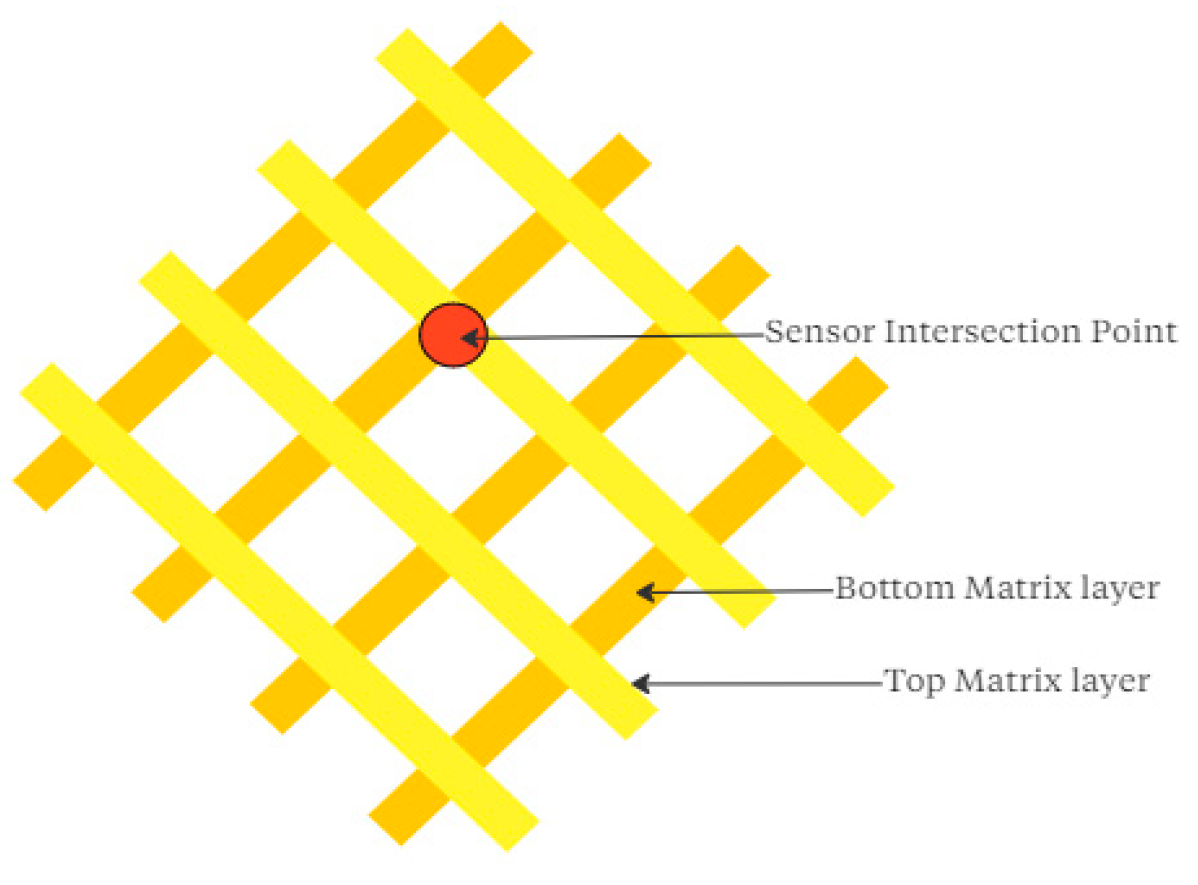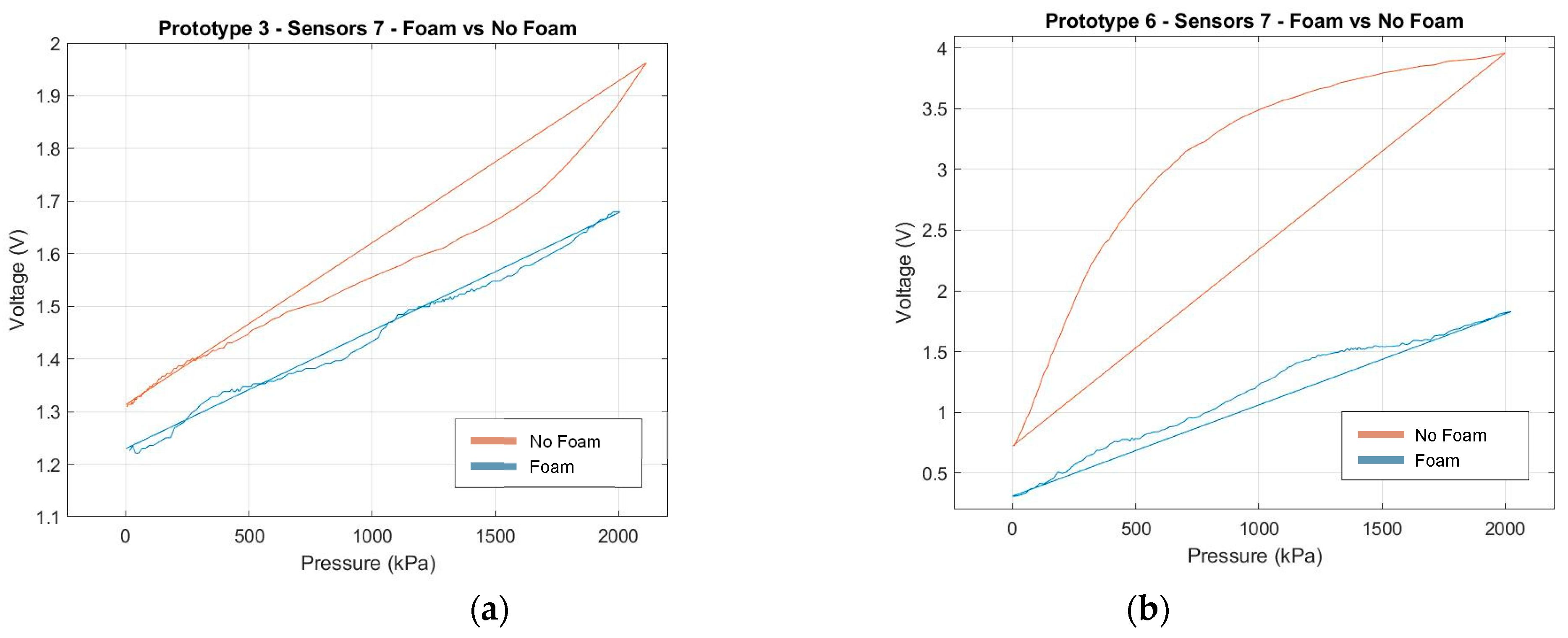Smart Textile Pressure Sensor Matrices—Investigation of Sensor Characteristics for Use in the Surgical Environment †
Abstract
1. Introduction
2. Materials and Methods
2.1. Design of Sensor Matrices
2.2. Test Methodology
2.3. Sensor Characterisation
3. Results
4. Discussion and Conclusions
Author Contributions
Funding
Data Availability Statement
Acknowledgments
Conflicts of Interest
References
- King, C.H.; Culjat, M.O.; Franco, M.L.; Lewis, C.E.; Dutson, E.P.; Grundfest, W.S.; Bisley, J.W. Tactile feedback induces reduced grasping force in robot-assisted surgery. IEEE Trans. Haptics 2009, 2, 103–110. [Google Scholar] [CrossRef]
- Matar, G.; Lina, J.M.; Kaddoum, G. Artificial Neural Network for in-Bed Posture Classification Using Bed-Sheet Pressure Sensors. IEEE J. Biomed. Health Inf. 2020, 24, 101–110. [Google Scholar] [CrossRef] [PubMed]
- Lin, S.; Hey, H.W.; Lau, E.T.; Tan, K.A.; Thambiah, J.S.; Lau, L.L.; Kumar, N.; Liu, K.P.; Wong, H.K. Prevalence and Predictors of Pres-sure Injuries From Spine Surgery in the Prone Position: Do Body Morphological Changes During Deformity Correction Increase the Risks? SPINE 2017, 42, 1730–1736. [Google Scholar] [CrossRef] [PubMed]




| Prototype | NL No Foam % | NL Foam % |
|---|---|---|
| 1 | 42.66 | 37.01 |
| 2 | 9.17 | 5.21 |
| 3 | −14.69 | −3.14 |
| 4 | 11.89 | 26.28 |
| 5 | 45.83 | 41.01 |
| 6 | 35.60 | 11.47 |
| 7 | 43.40 | 23.81 |
| 8 | 41.78 | 36.62 |
| Prototype Number | Sensitivity No Foam mV/Pa | Span of Millivolts from 0N–200N No Foam | Sensitivity Foam mV/Pa | Span of Millivolts from 0N–200N No Foam |
|---|---|---|---|---|
| 1 | 0.0391 | 835 | 0.0861 | 1733 |
| 2 | 0.1099 | 2304.3 | 0.0474 | 942.3 |
| 3 | 0.0355 | 748 | 0.0231 | 459 |
| 4 | 0.0942 | 1977 | 0.0944 | 1884.7 |
| 5 | 0.0297 | 596 | 0.0857 | 1709 |
| 6 | 0.1623 | 3235.6 | 0.0753 | 1523.4 |
| 7 | 0.0596 | 1196 | 0.0648 | 1285 |
| 8 | 0.0832 | 1685 | 0.105 | 2100 |
Disclaimer/Publisher’s Note: The statements, opinions and data contained in all publications are solely those of the individual author(s) and contributor(s) and not of MDPI and/or the editor(s). MDPI and/or the editor(s) disclaim responsibility for any injury to people or property resulting from any ideas, methods, instructions or products referred to in the content. |
© 2024 by the authors. Licensee MDPI, Basel, Switzerland. This article is an open access article distributed under the terms and conditions of the Creative Commons Attribution (CC BY) license (https://creativecommons.org/licenses/by/4.0/).
Share and Cite
Sizer, N.D.; Dalbert, C.; Loeser, S.; Wei, Y.; Fleischer, J.; Stark, P.; Siena, F.L.; Breedon, P. Smart Textile Pressure Sensor Matrices—Investigation of Sensor Characteristics for Use in the Surgical Environment. Eng. Proc. 2023, 52, 19. https://doi.org/10.3390/engproc2023052019
Sizer ND, Dalbert C, Loeser S, Wei Y, Fleischer J, Stark P, Siena FL, Breedon P. Smart Textile Pressure Sensor Matrices—Investigation of Sensor Characteristics for Use in the Surgical Environment. Engineering Proceedings. 2023; 52(1):19. https://doi.org/10.3390/engproc2023052019
Chicago/Turabian StyleSizer, Nicolette D., Charly Dalbert, Steffen Loeser, Yang Wei, Julia Fleischer, Pascal Stark, Francesco L. Siena, and Philip Breedon. 2023. "Smart Textile Pressure Sensor Matrices—Investigation of Sensor Characteristics for Use in the Surgical Environment" Engineering Proceedings 52, no. 1: 19. https://doi.org/10.3390/engproc2023052019
APA StyleSizer, N. D., Dalbert, C., Loeser, S., Wei, Y., Fleischer, J., Stark, P., Siena, F. L., & Breedon, P. (2023). Smart Textile Pressure Sensor Matrices—Investigation of Sensor Characteristics for Use in the Surgical Environment. Engineering Proceedings, 52(1), 19. https://doi.org/10.3390/engproc2023052019







